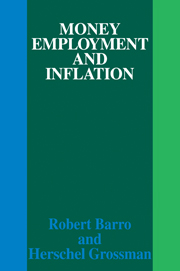Book contents
- Frontmatter
- Contents
- Dedication
- Preface
- Introduction
- 1 The basic model
- 2 Output and employment under non-market-clearing conditions
- 3 Capital, financial assets, and the rate of return
- 4 Inflation and rates of return
- 5 Inflation and unemployment
- 6 The dynamics of aggregate demand
- 7 Output and employment with wage and price speculation
- References
- Index of names
4 - Inflation and rates of return
Published online by Cambridge University Press: 07 October 2011
- Frontmatter
- Contents
- Dedication
- Preface
- Introduction
- 1 The basic model
- 2 Output and employment under non-market-clearing conditions
- 3 Capital, financial assets, and the rate of return
- 4 Inflation and rates of return
- 5 Inflation and unemployment
- 6 The dynamics of aggregate demand
- 7 Output and employment with wage and price speculation
- References
- Index of names
Summary
This chapter introduces into the analytical framework expectations of nonzero rates of price and wage change and focuses on one important implication of these expectations–the divergence between the nominal and the real rate of return. Section 4.1 explains these two rate-of-return concepts. Section 4.2 analyzes how inflationary or deflationary expectations affect firm and household behavior. Section 4.3 analyzes the comparative-statics implications of shifts in these expectations. Section 4.4 develops a dynamic analysis of the interplay between inflation, expected inflation, and rates of return.
Rates of return and expected rates of price and wage change
In chapter 3 we analyzed the determination of the values of the endogenous variables – including the levels of output, employment, the wage rate, the price of commodities, and the rate of return – which would be consistent with general-market-clearing conditions. The analysis focused on exogenous disturbances which would alter the general-market-clearing vector of wages and prices and, consequently, would result in corresponding changes in actual wages and prices. However, despite the existence of these disturbances, the analysis in chapter 3, like the analysis in chapters 1 and 2, assumed that firms and households, in attempting to maximize profits and utility, took P, W and r to be constant over time.
By taking P and W, in particular, to be constant, firms and households made their plans as if nominal and real rates of return were equivalent.
- Type
- Chapter
- Information
- Money Employment and Inflation , pp. 154 - 187Publisher: Cambridge University PressPrint publication year: 1976



